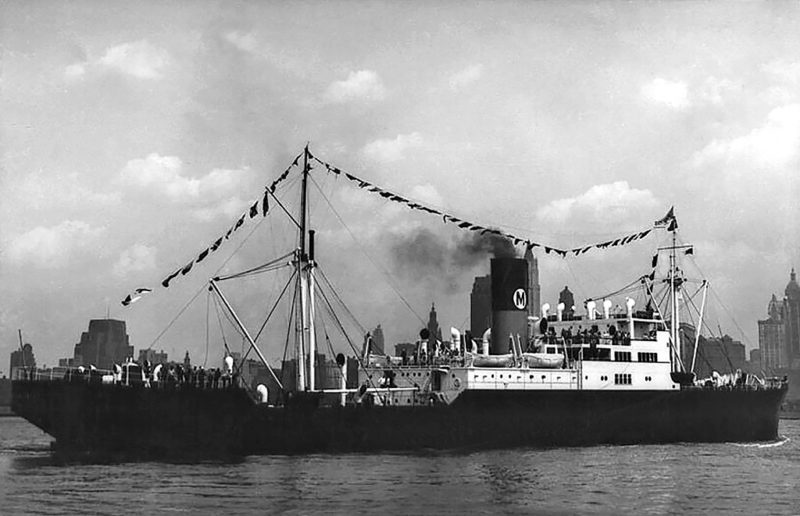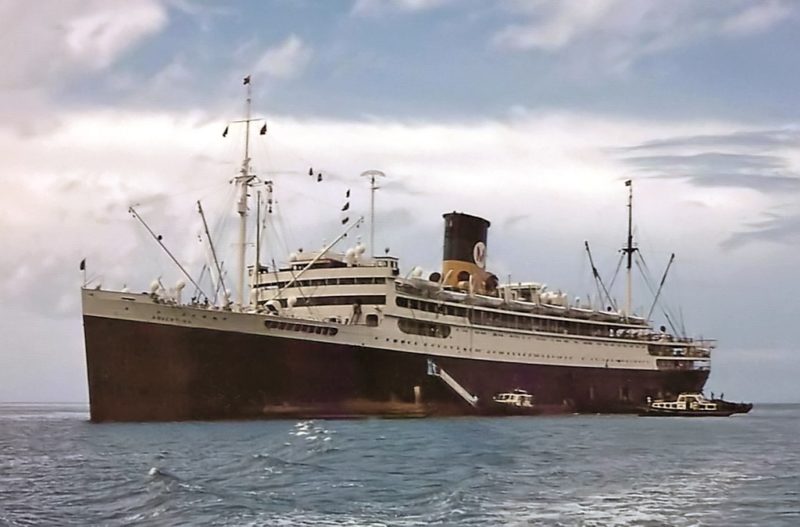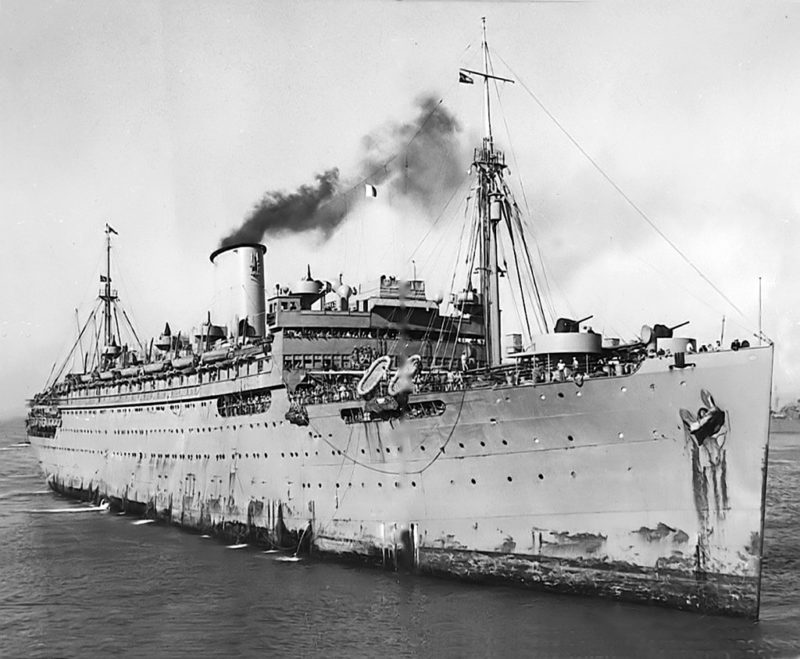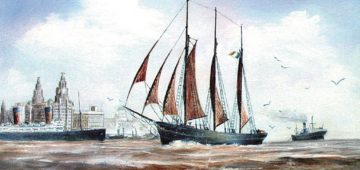
The iconic Moore-McCormack Lines was founded in New York on 9th July 1913 by Albert V. Moore (1880-1953) and Emmet J. McCormack (1880-1965) with a capital of $5,000. One small ship, Montara of 2,562 grt built back in 1881, loaded coal in 1913 at Norfolk (Virginia) for Searsport (Maine), and then moved down to Wilmington (Delaware) to load dynamite for Rio de Janeiro. Albert V. Moore lived in Hackensack (New Jersey) and Emmet J. McCormack lived in Brooklyn (New York) and both were young men when they began their partnership.
Mr. Moore came from a family of shipowners and shipmasters and obtained his early experience in the New York office of British shipowners, Bowring & Company. Profitable voyages were made by other cargo ships to Brazilian ports during World War I, including the former Great Lakers Barnstaple of 1,358 grt and Mooremack of 1,043 grt.
At the end of 1916, the first passenger ship was chartered for two years in Saga of 2,809 grt built in 1909 by Swan, Hunter & Wigham Richardson Ltd. for the Thule Line and Swedish Lloyd Line service on the North Sea between England and Sweden. Saga had been launched on 21st April 1909 at the Neptune Yard and ran her trials on 10th June 1909.
During the First World War, Saga was the only American ship sailing between American ports and Rio de Janeiro, with Brazilian industrial production doubling and agricultural diversity increasing. Later, further Swedish Lloyd Line passenger ships such as Calabria 1,825/16, Graecia 2,951/11, and Anglia 1,750/14 were taken on charter for South American services, with Anglia sinking on 18th June 1931 after a collision at San Nicolas in Argentina.
Moore-McCormack vessels averaged fifteen sailings per annum to Brazilian ports during World War I. The larger cargo ship Nantahala of 5,714 grt, built in 1918 by the Western Pipe & Steel yard at San Francisco, introduced the Mooremack flag as far south as Buenos Aires.
During 1919 and subsequent early inter-war years, 28 vessels were purchased from the vast stock of 2,311 surplus war built ships of the U.S. Shipping Board in order for them to enter commercial service, these were:-
- 15 engines ‘midships ‘Hog Islander’ cargo ships of 5,150 grt built in 1919, which kept their original names for the American Scantic Line service to Copenhagen, Oslo, Helsingfors, Polish and Russian ports, until four were converted into passenger and cargo-liners in 1932 and renamed Scanmail, Scanpenn, Scanstates and Scanyork.
- 8 engines ‘midships ‘Great Lakers’ of 2,606 grt which were built in 1919 with ‘Lake’ prefixes to their names and were renamed with ‘Commercial’ prefixes e.g. Commercial Quaker for the Mooremack Gulf Lines services from U.S. Gulf ports to Mexican ports to load fruit and other perishables for Eastern Seaboard ports.
- 5 captured German prizes of varying sizes from the Deutsche Australien Line, Hapag, Norddeutscher Lloyd, Kosmos Line and Holm & Molzen fleets and also given ‘Commercial’ prefixes to their names.

During the inter-war years, Moore-McCormack managed nine subsidiaries with various titles for various routes. In 1932, twenty ships were being managed, increased in the following year by the purchase of Crofton Hall 5,774/1913 built from the Lancashire Shipping Co. Ltd. fleet, managed by C. G. Dunn & Co. Ltd. of Liverpool, and renamed Commercial Traveler. On 8th September 1938, these nine subsidiaries were consolidated within this group to become Moore-McCormack Lines Inc.

These nine subsidiaries were:-
- American Caribbean Line with Caribbean services.
- American Republics Line with services between the Eastern Seaboard of the U.S.A. and East Coast ports of the South American countries of Brazil, Uruguay and Argentina via Barbados outward and Trinidad homeward, and with ships that were previously in the service of the Panama Pacific Line.
- American Scantic Line Inc. with services to Scandinavian and Baltic countries.
- Honolulu Steamship Co. Inc. for services to the islands of Hawaii.
- Calmar Steamship Corporation for iron ore and bulk dry cargoes.
- Mooremack Lines Inc. with services with services from U.S. ports to Caribbean.
- Mooremack Gulf Lines Inc. with services from U.S. Gulf ports to Mexico for fruit and return to Eastern Seaboard ports.
- Moore-McCormack Co. Inc. as the main holding company with services to South America, the Mediterranean, Black Sea ports, Levant countries and India.
Pacific Republics Line with cargo services between Los Angeles, San Francisco, Portland and Seattle to Central and South America.
Hull colours were either black or grey, masts and derricks were cream, while funnel colours were yellow with a green central band and a black top, with a logo on the green band that showed the various inter-war years subsidiaries.
URUGUAY, BRAZIL and ARGENTINA
Moore-McCormack Lines survived the inter-war years trading on many routes, with passenger numbers to South America sharply down to low unprofitable figures during the Depression years. The company had achieved a large fleet strength of 40 ships in 1939 serving the East Coast of South America and other world services from New York. This was helped by the granting of large amounts of economic aid to Brazil by the U.S.A., including a cheap loan to enable the Brazilian Government to build a large integrated steel mill at Volta Redonda. On 4th October 1938, as part of a consolidation of nine companies within the Moore-McCormack Group, twenty ships had been purchased from the United States Maritime Commission for $4.8 million, with the general cargo ships renamed with the ‘Mormac’ prefix to their names. This prefix was to become very familiar in post-war years for the cargo-liners, with the passenger liners continuing to use South American country names.
Three former twin funnelled passenger liners with excellent accommodation for 750 passengers were also included in the purchase. These were the Uruguay, Brazil and the Argentina. The turbo-electric trio had been built by the Newport News Shipbuilding and Dry Dock Company as California, Virginia and Pennsylvania for the New York to San Francisco service via the Panama Canal of the Panama Pacific Line. In 1937, after their subsidy had been withdrawn and Panama Canal charges had increased, the trio had been sold to the United States Maritime Commission and rebuilt for South American service with only one funnel. They ran on the American Republic Line service from American ports to South America with Moore & McCormack as managers for Uruguay, Brazil and Argentina. The American Republic Line had begun during the Depression as a trade initiative by President Franklin Roosevelt, and its funnel colours were yellow with a blue diamond between two thin black bands, the upper of which was at the top of the funnel.
The trio had an overall length of 601 feet, moulded beam of 80 feet and a loaded draft to the bottom of the keel of 32.3 feet, and a gross tonnage of over 20,000. First Class passengers numbered 386 and Tourist Class passengers numbered 363. Their turbo-electric propulsion produced 17,000 shaft horse power giving a service speed of 18 knots. First Class passengers were accommodated ‘midships over four decks, namely Boat Deck, Promenade Deck, Upper Deck and Main Deck, with the Tourist Class passengers aft. Boat Deck had the Navigating Officers accommodated at the forward end, with the Engineering Officers around the funnel exhaust spaces, and the rest of the crew were accommodated on two decks below Main Deck and in the fo’c’stle.
First Class public rooms of the trio were the Library, Lounge, Lounge Lobby, Smoking Room, Verandah café, Children’s playroom and Gymnasium, all on the Promenade Deck. The elegant First Class Lounge had a central glass dome, crystal ceiling fixtures, and a raised dais for the ship’s orchestra. The Tourist Class public rooms comprised a Lounge, Smoking Room and Dining Room, the latter and the First Class Dining Room seating 300 passengers being ‘midships on the Upper Deck, with the pantries and galleys between the two rooms. The First Class Dining Room had a central area two decks high with supporting columns to the sides and tables for six or eight passengers. Two outdoor swimming pools were provided by adapting number 2 trunked hatch and number 8 trunked hatch. The hatches were specially designed for the purpose, having jointed hinged bottoms for the pools, and allowed full use of the hatch for cargo. All passengers had outside staterooms, and there were two special De Luxe staterooms that included sitting rooms, bedrooms and private baths, and many other First Class cabins had bathrooms.

Subscribe today to read the full article!
Simply click below to subscribe and not only read the full article instantly, but gain unparalleled access to the specialist magazine for shipping enthusiasts.






Comments
Sorry, comments are closed for this item